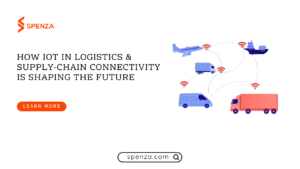Table of Contents
- Introduction
- What is eSIM and How Does It Work?
- Why More Businesses Are Switching to eSIM
- Key IoT Applications Where eSIM is Making an Impact
- Smart Cities and Infrastructure
- Logistics, Fleet Management, and Asset Tracking
- Healthcare and Wearables
- Industrial IoT (IIoT) and Smart Manufacturing
- Automotive and Connected Vehicles
- How Spenza Simplifies eSIM Management for IoT
- Final Thoughts: The Future of IoT is eSIM-Enabled
- FAQs

Introduction
Industries are changing through The Internet of Things (IoT), which connects devices, streamlines and automates processes, and increases efficiency. For smart cities and connected cars to machinery in factories and remote health care, IoT devices need a continual and reliable connection to fully realize their value.
But traditional SIM cards come with headaches. They lock devices into one network, making it hard to switch when coverage is weak or costs are too high. Managing physical SIMs also adds extra work—someone has to store, swap, and set them up manually. For businesses running large IoT deployments, this isn’t just inconvenient—it’s expensive and inefficient.
This is where eSIM (Embedded SIM) technology is changing the game for IoT connectivity. The primary difference is that traditional plastic SIM cards which must be inserted, removed, and replaced, eSIM is an embedded, programmable microchip that can be activated and switched to a different carrier over the air with no physical handling required.
Dealing with complex SIM management is a common pain point for businesses deploying IoT devices, but eSIM technology help you navigate through those pains and manage IoT devices much easier, enabling them to scale globally without getting caught up with connectivity.
eSIM simplifies the complex processes of traditional SIM management which allows businesses to install and manage their IoT devices in a seamless manner and enables them to scale globally without facing connectivity hurdles as well as lowers their operational expenses. Here’s a breakdown of how eSIM is revolutionizing IoT connectivity, the major advantages for enterprises, and how Spenza makes eSIM management easy for seamless and affordable IoT launches.
What is eSIM and How Does It Work?

Understanding the Basics of eSIM
An eSIM (Embedded SIM) is a built-in SIM that is not removable and can be configured via software directly in the hardware. Traditional SIM cards are physical chips that users must insert and swap out themselves when changing carriers, but an eSIM is built directly into the device at manufacture.
This fundamental shift in SIM technology brings in a new level of flexibility, efficiency, and scalability to IoT connectivity.
Remote SIM Provisioning (RSP) and Over-the-Air (OTA) Activation
eSIM specifically enables Remote SIM Provisioning (RSP), which brings one of its key benefits as it enables businesses to manage network profiles OTA (over-the-air) without the need for a physical interface. This means that:
- No more replacing SIM cards manually – Enterprises can activate, upgrade, and change network providers without the inconvenience of physically altering the equipment.
- Immediate connectivity activation – Devices can be deployed with eSIM already pre-installed and activated remotely, speeding up deployment and logistics.
- Seamless carrier switching – The ability for organizations to switch dynamically between network providers based on availability, performance, or cost, without needing new SIM hardware.
How eSIM Enables Seamless Network Switching
Unlike traditional SIM cards that lock devices into a single carrier, eSIMs are designed to be carrier-agnostic. This allows businesses to:
- Maintain continuous connectivity – Devices can automatically switch to the strongest available network, ensuring uninterrupted service even in remote areas.
- Reduce roaming charges – Instead of incurring high roaming fees, businesses can program devices to switch to a local carrier when moving between different regions.
- Improve device longevity and lifecycle management – eSIMs eliminate the risk of physical SIM wear and tear, making them ideal for long-term IoT deployments.
Security Enhancements with eSIM
eSIM technology also brings significant security benefits over traditional SIM cards:
- Tamper-resistant – Since eSIMs are soldered directly into a device’s chipset, they are much harder to remove or manipulate, reducing the risk of SIM theft or fraud.
- Encrypted profile management – Remote SIM provisioning ensures that network credentials and profiles are securely updated over encrypted channels, reducing the risk of unauthorized access.
- Better compliance with security regulations – eSIM technology supports authentication mechanisms that meet industry security standards, making it a safer choice for IoT applications.
A Future-Proof Solution for IoT Deployments
Businesses rolling out IoT devices at scale need a reliable way to keep them connected. Traditional SIM cards come with challenges—physical swaps, carrier restrictions, and high costs. eSIM removes those obstacles. It lets devices switch networks remotely, reduces operating expenses, and strengthens security. Whether it’s a smart city project, a logistics network, or an industrial automation setup, eSIM keeps everything running smoothly without the hassle of managing physical SIM cards.
Why More Businesses Are Switching to eSIM
More companies are choosing eSIM because it simplifies connectivity, reduces costs, and improves reliability. Here’s why:
| Reason | Challenges with Traditional SIMs | How eSIM Solves It |
|---|---|---|
| No More Swapping SIM Cards | Businesses must manually replace SIMs to switch carriers or update plans, causing downtime and extra costs. | eSIM enables remote network updates, eliminating the need for physical SIM swaps and on-site technicians. |
| Reliable Connectivity Anywhere | Traditional SIMs can lead to spotty coverage, high roaming fees, and carrier lock-in. | eSIM allows devices to switch to the best available network automatically, ensuring seamless connectivity. |
| Lower Costs, Less Complexity | Managing physical SIMs involves purchasing, storing, replacing them, and dealing with multiple carrier contracts. | eSIM enables centralized, over-the-air management, reducing logistics and administrative costs. |
| Better Security, Less Risk | Physical SIMs can be stolen, tampered with, or misused, posing security threats. | eSIM is embedded in devices, making it tamper-proof. Businesses can enforce security policies remotely and disable compromised profiles instantly. |
| A More Reliable Network | Devices relying on a single carrier are vulnerable to outages and poor coverage. | eSIM enables automatic network switching, minimizing downtime and keeping operations running smoothly. |
The Shift to eSIM
Businesses are moving to eSIM because it eliminates the challenges of traditional SIM cards. With remote provisioning, better security, and more reliable coverage, eSIM makes managing IoT connectivity easier and more cost-effective. For companies scaling their IoT operations, it’s becoming the smarter choice.
Why eSIM is Becoming the Standard for IoT
Businesses are switching to eSIM because it removes the complexity of traditional SIM management. It allows for remote network provisioning, improves security, and ensures devices stay connected across regions. For companies managing large-scale IoT deployments, eSIM makes operations smoother, more cost-effective, and more reliable.
Key IoT Applications Where eSIM is Making an Impact
The adoption of eSIM technology is accelerating across industries, enabling smarter, more efficient, and cost-effective IoT deployments. Among the most important use cases are:

Infrastructure and Smart Cities
Smart meters, environmental sensors, and intelligent traffic management systems are just a few of the IoT solutions that municipalities are incorporating to improve urban infrastructure. Even in places where network coverage varies, eSIM guarantees dependable, multi-network connectivity for these devices.
Asset tracking, fleet management, and logistics
Real-time location tracking, route optimization, and remote diagnostics are made possible by eSIM for companies that manage automobile fleets, supply chains, and valuable assets. The seamless network switching between regions guarantees uninterrupted asset connectivity.
Wearables and Healthcare
eSIM is used in the healthcare industry by wearables, connected medical devices, and remote patient monitoring devices to safely send real-time health data. This guarantees ongoing monitoring, particularly for cross-border telemedicine applications, without requiring manual SIM replacements.
Industrial IoT (IIoT) and Smart Manufacturing
To maximize output, factories and industrial settings use automated equipment, linked sensors, and AI-powered analytics platforms. By lowering downtime and facilitating real-time data exchange between devices and cloud platforms, eSIM offers flexible, scalable, and secure connectivity.
Automobiles and Networked Automobiles
eSIM is revolutionizing connected cars with features like over-the-air (OTA) software updates and real-time GPS navigation. Automakers can guarantee flawless network coverage globally, enhance vehicle diagnostics, and remotely manage connectivity.
How Spenza Makes eSIM Management for IoT Easier
A reliable, intelligent, and automated platform is necessary for the large-scale deployment and management of eSIM-based IoT connectivity. Businesses can easily switch networks based on availability, performance, or cost with Spenza’s AI-driven eSIM management solution, which also enables remote activation and carrier switching.
- Multi-carrier optimization: makes sure that, wherever they are, devices are always connected to the most effective network.
- Automated cost management: Cut costs with smart network selection and usage tracking.
- Real-time data insights: Monitor the connectivity of IoT devices, identify irregularities, and avoid needless expenses.
Businesses can future-proof their IoT deployments with seamless eSIM integration, cut down on connectivity costs, and do away with manual SIM handling with Spenza.
Final Thoughts: Embracing eSIM for IoT
IoT For businesses using IoT extensively, switching from physical SIM cards to eSIM is a major upgrade. eSIM brings much more flexibility, reduces costs, and allows for easier expansion of IoT systems. It lets devices connect to networks remotely, makes network switching simple, and boosts security. Spenza has an eSIM platform that gives businesses a straightforward, AI-driven solution to enhance IoT connections, simplify how things work, and better handle costs.
FAQs
eSIM is integrated into a device and can be remotely programmed and updated, in contrast to conventional SIM cards that must be manually changed.
Indeed, eSIM makes it possible for companies to remotely switch between several network providers, guaranteeing uninterrupted worldwide connectivity.
Of course. eSIM improves device security and lowers SIM fraud because it cannot be removed or tampered with.
Significant cost savings result from eSIM’s ability to replace SIM cards manually, lower roaming costs, and automate carrier management.
Spenza provides an eSIM platform powered by AI that streamlines connectivity management, reduces costs, and ensures seamless IoT deployments.
Reach out to Spenza today to find out how eSIM can revolutionize your IoT connectivity plans.






